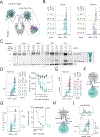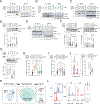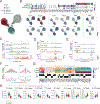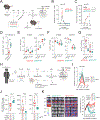Signaling via a CD27-TRAF2-SHP-1 axis during naive T cell activation promotes memory-associated gene regulatory networks
- PMID: 38354704
- PMCID: PMC10967230
- DOI: 10.1016/j.immuni.2024.01.011
Signaling via a CD27-TRAF2-SHP-1 axis during naive T cell activation promotes memory-associated gene regulatory networks
Abstract
The interaction of the tumor necrosis factor receptor (TNFR) family member CD27 on naive CD8+ T (Tn) cells with homotrimeric CD70 on antigen-presenting cells (APCs) is necessary for T cell memory fate determination. Here, we examined CD27 signaling during Tn cell activation and differentiation. In conjunction with T cell receptor (TCR) stimulation, ligation of CD27 by a synthetic trimeric CD70 ligand triggered CD27 internalization and degradation, suggesting active regulation of this signaling axis. Internalized CD27 recruited the signaling adaptor TRAF2 and the phosphatase SHP-1, thereby modulating TCR and CD28 signals. CD27-mediated modulation of TCR signals promoted transcription factor circuits that induced memory rather than effector associated gene programs, which are induced by CD28 costimulation. CD27-costimulated chimeric antigen receptor (CAR)-engineered T cells exhibited improved tumor control compared with CD28-costimulated CAR-T cells. Thus, CD27 signaling during Tn cell activation promotes memory properties with relevance to T cell immunotherapy.
Keywords: CAR-T cell therapy; CD27; CD8(+) T cell; SHP-1 phosphatase; chimeric antigen receptor; costimulation; memory and effector fate determination; naive T cell activation.
Copyright © 2024 The Authors. Published by Elsevier Inc. All rights reserved.
Conflict of interest statement
Declaration of interests C.A.J.-R., C.E.C., and S.R.R. are inventors on a patent (“engineered trimeric CD70 proteins and uses thereof”; WO2021072127A3) filed by Fred Hutchinson Cancer Center and licensed by Lyell Immunopharma. S.R.R. was a founder, has served as an advisor, and has patents licensed to Juno Therapeutics; S.R.R is a founder of and holds equity in Lyell Immunopharma and has served on the advisory boards for Adaptive Biotechnologies and Nohla.
Figures






References
-
- Hintzen RQ, de Jong R, Lens SM, Brouwer M, Baars P, and van Lier RA (1993). Regulation of CD27 expression on subsets of mature T-lymphocytes. J Immunol 151, 2426–2435. - PubMed
-
- van Lier RA, Borst J, Vroom TM, Klein H, Van Mourik P, Zeijlemaker WP, and Melief CJ (1987). Tissue distribution and biochemical and functional properties of Tp55 (CD27), a novel T cell differentiation antigen. J Immunol 139, 1589–1596. - PubMed
Publication types
MeSH terms
Substances
Grants and funding
LinkOut - more resources
Full Text Sources
Molecular Biology Databases
Research Materials
Miscellaneous

